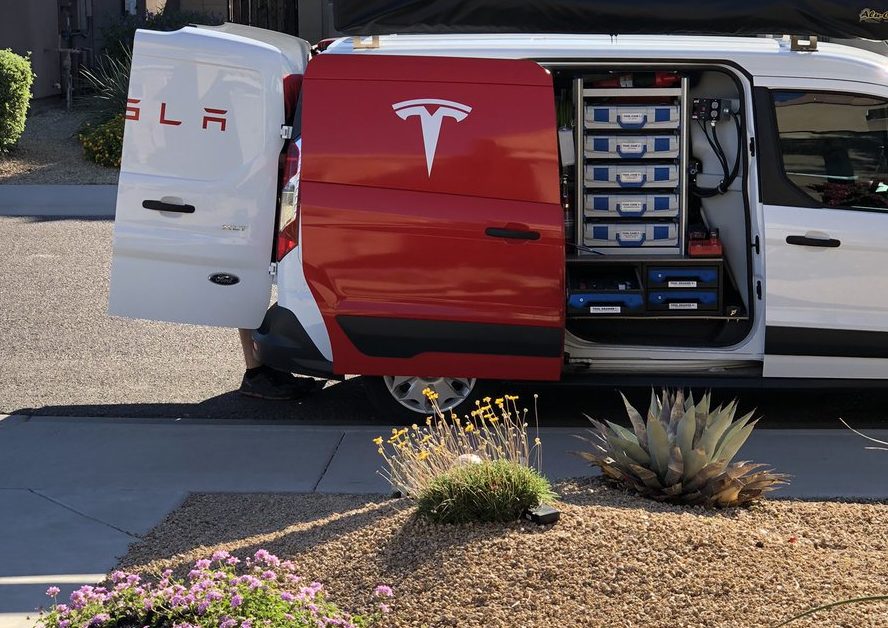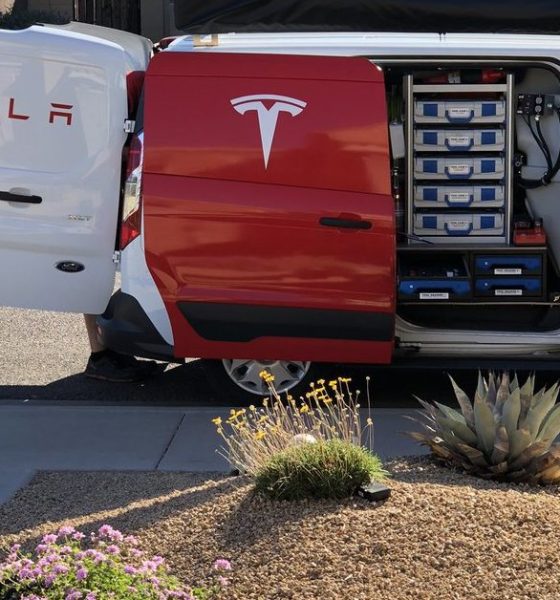

News
Tesla to allow service requests with ‘1 or 2 taps’ in mobile app, says Elon Musk
Earlier this year, Elon Musk noted that Tesla owners would be able to request service for their vehicles through their smartphones. During his announcements then, Musk stated that the higher operating costs of the smartphone-based service requests would be “worth doing” for the company, considering that it would result in better “owner happiness.”
A recent set of tweets from Elon Musk provided a number of additional details for the company’s upcoming mobile app-based service request system. For one, Musk stated that the company is “adding functionality to the Tesla phone app allowing owners to request service for top issues” with just one or two taps. With such a system in place, owners of Tesla’s electric cars would soon be able to request service in a manner that is convenient and quick.
Adding functionality to Tesla phone app allowing owners to request service for top issues with 1 or 2 taps https://t.co/zb7A6fMROe
— Elon Musk (@elonmusk) November 19, 2018
Musk further noted that in the event of a breakdown or accident (assuming that there are no injuries, of course), Tesla Service would arrive at the scene with a top-of-the-line loaner vehicle that’s ready for use. While a vehicle is being repaired, Tesla could also push data to the mobile app that would allow owners to view updates on the progress of their electric cars’ diagnosis.
Yeah, good idea. We have that state internally, so can push data to phone app.
— Elon Musk (@elonmusk) November 19, 2018
With the ongoing production ramp of the Model 3, Tesla is now at a point where the size of its fleet is bound to get larger over the coming quarters and years. The release of high-volume vehicles like the Model Y, and possibly even the Tesla pickup truck, as well as the arrival of other vehicles like the Tesla Roadster and the Tesla Semi, would all but increase the number of the company’s electric cars on the road.
The increasing number of Tesla electric cars highlight the need to deploy a service system that can handle the needs and demands of a large fleet. Tesla is already preparing for such a scenario by improving its service capabilities, such as the launch of in-house body shops that are capable of conducting minor bodywork repair, as well as the ramp of its mobile service vehicles. Tesla mentioned these improvements specifically in the company’s Q3 2018 Update Letter.
“We expect our Services and Other business to continue to grow mainly due to used car sales volumes. We will increase investment in our service infrastructure in North America through (the) deployment of new service locations and additional mobile service vehicles.”
Tesla’s Support Page notes that Roadside Assistance services are offered to owners as a way to “minimize inconvenience” in the event that a vehicle becomes inoperable. The service, which is available 24/7, is provided for the first four years of ownership, or 50,000 miles. Depending on the car, additional coverage for the battery and drive unit are also offered with a separate policy for 8 years or 125,000 miles, or 8 years and unlimited miles.
Tesla Roadside Assistance currently offers transportation services of up to 500 miles to the nearest Service Center in the event of a warrantable breakdown that renders the vehicle undrivable. Flat tire services, aid in the event that an owner is locked outside the car, and assistance in the event that an electric car runs out of range, are also offered as part of Tesla’s Roadside Assistance services.
Tesla stands as one of the carmakers in the market today with a high Net Promoter Score. IndexNPS, which tracks the NPS scores of companies, notes that Tesla’s score of 96 is higher than legacy carmakers like Porsche, Audi, Toyota, Subaru, Honda, Hyundai and GMC, whose scores range between 73 and 84. One of the reasons behind these is the company’s proactive approach to improving its services, as evidenced by the expansion of its mobile service fleet, as well as its mobile app’s upcoming capability to conduct service requests.

Elon Musk
Starlink passes 9 million active customers just weeks after hitting 8 million
The milestone highlights the accelerating growth of Starlink, which has now been adding over 20,000 new users per day.

SpaceX’s Starlink satellite internet service has continued its rapid global expansion, surpassing 9 million active customers just weeks after crossing the 8 million mark.
The milestone highlights the accelerating growth of Starlink, which has now been adding over 20,000 new users per day.
9 million customers
In a post on X, SpaceX stated that Starlink now serves over 9 million active users across 155 countries, territories, and markets. The company reached 8 million customers in early November, meaning it added roughly 1 million subscribers in under seven weeks, or about 21,275 new users on average per day.
“Starlink is connecting more than 9M active customers with high-speed internet across 155 countries, territories, and many other markets,” Starlink wrote in a post on its official X account. SpaceX President Gwynne Shotwell also celebrated the milestone on X. “A huge thank you to all of our customers and congrats to the Starlink team for such an incredible product,” she wrote.
That growth rate reflects both rising demand for broadband in underserved regions and Starlink’s expanding satellite constellation, which now includes more than 9,000 low-Earth-orbit satellites designed to deliver high-speed, low-latency internet worldwide.
Starlink’s momentum
Starlink’s momentum has been building up. SpaceX reported 4.6 million Starlink customers in December 2024, followed by 7 million by August 2025, and 8 million customers in November. Independent data also suggests Starlink usage is rising sharply, with Cloudflare reporting that global web traffic from Starlink users more than doubled in 2025, as noted in an Insider report.
Starlink’s momentum is increasingly tied to SpaceX’s broader financial outlook. Elon Musk has said the satellite network is “by far” the company’s largest revenue driver, and reports suggest SpaceX may be positioning itself for an initial public offering as soon as next year, with valuations estimated as high as $1.5 trillion. Musk has also suggested in the past that Starlink could have its own IPO in the future.
News
NVIDIA Director of Robotics: Tesla FSD v14 is the first AI to pass the “Physical Turing Test”
After testing FSD v14, Fan stated that his experience with FSD felt magical at first, but it soon started to feel like a routine.

NVIDIA Director of Robotics Jim Fan has praised Tesla’s Full Self-Driving (Supervised) v14 as the first AI to pass what he described as a “Physical Turing Test.”
After testing FSD v14, Fan stated that his experience with FSD felt magical at first, but it soon started to feel like a routine. And just like smartphones today, removing it now would “actively hurt.”
Jim Fan’s hands-on FSD v14 impressions
Fan, a leading researcher in embodied AI who is currently solving Physical AI at NVIDIA and spearheading the company’s Project GR00T initiative, noted that he actually was late to the Tesla game. He was, however, one of the first to try out FSD v14.
“I was very late to own a Tesla but among the earliest to try out FSD v14. It’s perhaps the first time I experience an AI that passes the Physical Turing Test: after a long day at work, you press a button, lay back, and couldn’t tell if a neural net or a human drove you home,” Fan wrote in a post on X.
Fan added: “Despite knowing exactly how robot learning works, I still find it magical watching the steering wheel turn by itself. First it feels surreal, next it becomes routine. Then, like the smartphone, taking it away actively hurts. This is how humanity gets rewired and glued to god-like technologies.”
The Physical Turing Test
The original Turing Test was conceived by Alan Turing in 1950, and it was aimed at determining if a machine could exhibit behavior that is equivalent to or indistinguishable from a human. By focusing on text-based conversations, the original Turing Test set a high bar for natural language processing and machine learning.
This test has been passed by today’s large language models. However, the capability to converse in a humanlike manner is a completely different challenge from performing real-world problem-solving or physical interactions. Thus, Fan introduced the Physical Turing Test, which challenges AI systems to demonstrate intelligence through physical actions.
Based on Fan’s comments, Tesla has demonstrated these intelligent physical actions with FSD v14. Elon Musk agreed with the NVIDIA executive, stating in a post on X that with FSD v14, “you can sense the sentience maturing.” Musk also praised Tesla AI, calling it the best “real-world AI” today.
News
Tesla AI team burns the Christmas midnight oil by releasing FSD v14.2.2.1
The update was released just a day after FSD v14.2.2 started rolling out to customers.

Tesla is burning the midnight oil this Christmas, with the Tesla AI team quietly rolling out Full Self-Driving (Supervised) v14.2.2.1 just a day after FSD v14.2.2 started rolling out to customers.
Tesla owner shares insights on FSD v14.2.2.1
Longtime Tesla owner and FSD tester @BLKMDL3 shared some insights following several drives with FSD v14.2.2.1 in rainy Los Angeles conditions with standing water and faded lane lines. He reported zero steering hesitation or stutter, confident lane changes, and maneuvers executed with precision that evoked the performance of Tesla’s driverless Robotaxis in Austin.
Parking performance impressed, with most spots nailed perfectly, including tight, sharp turns, in single attempts without shaky steering. One minor offset happened only due to another vehicle that was parked over the line, which FSD accommodated by a few extra inches. In rain that typically erases road markings, FSD visualized lanes and turn lines better than humans, positioning itself flawlessly when entering new streets as well.
“Took it up a dark, wet, and twisty canyon road up and down the hill tonight and it went very well as to be expected. Stayed centered in the lane, kept speed well and gives a confidence inspiring steering feel where it handles these curvy roads better than the majority of human drivers,” the Tesla owner wrote in a post on X.
Tesla’s FSD v14.2.2 update
Just a day before FSD v14.2.2.1’s release, Tesla rolled out FSD v14.2.2, which was focused on smoother real-world performance, better obstacle awareness, and precise end-of-trip routing. According to the update’s release notes, FSD v14.2.2 upgrades the vision encoder neural network with higher resolution features, enhancing detection of emergency vehicles, road obstacles, and human gestures.
New Arrival Options also allowed users to select preferred drop-off styles, such as Parking Lot, Street, Driveway, Parking Garage, or Curbside, with the navigation pin automatically adjusting to the ideal spot. Other refinements include pulling over for emergency vehicles, real-time vision-based detours for blocked roads, improved gate and debris handling, and Speed Profiles for customized driving styles.








